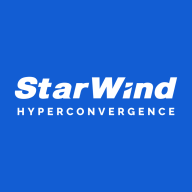


StarWind HyperConverged Appliance and IBM Spectrum Virtualize compete in the hyperconverged and storage virtualization solutions category. StarWind seems to have the upper hand in customer support and cost-effectiveness, while IBM Spectrum Virtualize stands out in storage and data migration capabilities.
Features: StarWind HyperConverged Appliance is notable for its flexibility, high availability, and proactive support. Users appreciate its ease of deployment and ability to consolidate storage and compute resources. The appliance includes turnkey solutions for seamless integration into existing infrastructure. IBM Spectrum Virtualize offers unparalleled storage virtualization capabilities, with robust data migration and disaster recovery features. It provides a powerful abstraction layer for managing diverse back-end storage options.
Room for Improvement: StarWind users seek an advanced GUI, improved monitoring tools, and better third-party software integration. Enhanced documentation and improvements in communication during support requests are also noted. For IBM Spectrum Virtualize, suggested improvements include more advanced GUI features, detailed reporting, and enhanced cognitive IT capabilities. Users desire data deduplication functionality and comprehensive multi-site support.
Ease of Deployment and Customer Service: StarWind is recognized for straightforward installation and minimal setup time, supported by proactive monitoring and a responsive support team. IBM Spectrum Virtualize offers seamless deployment but lacks StarWind's hands-on customer interaction, as evidenced by user experiences.
Pricing and ROI: StarWind HyperConverged Appliance offers an affordable solution with flexible financing options, making high availability accessible for small and medium enterprises. Users report significant ROI and competitive pricing compared to alternatives like Nutanix. IBM Spectrum Virtualize is valued for offering strong enterprise features at competitive prices but does not match StarWind’s upfront cost benefits. Its bundled licensing offers flexibility, beneficial for large-scale deployments, resulting in a solid ROI.
| Product | Market Share (%) |
|---|---|
| Pure Storage FlashBlade | 3.8% |
| StarWind HyperConverged Appliance | 2.0% |
| IBM Spectrum Virtualize | 1.6% |
| Other | 92.6% |



| Company Size | Count |
|---|---|
| Small Business | 11 |
| Midsize Enterprise | 11 |
| Large Enterprise | 21 |
| Company Size | Count |
|---|---|
| Small Business | 11 |
| Midsize Enterprise | 4 |
| Large Enterprise | 31 |
| Company Size | Count |
|---|---|
| Small Business | 50 |
| Midsize Enterprise | 22 |
| Large Enterprise | 8 |
FlashBlade is the industry’s most advanced scale-out storage for unstructured data, powered by a modern, massively parallel architecture to consolidate complex data silos (like backup appliances and data lakes) and accelerate tomorrow’s discoveries and insights.
IBM Spectrum Virtualize is a dependable solution that improves data value, security, and simplicity for new and existing storage infrastructure. Proven over 12 years in thousands of deployments, its innovative virtualization capabilities help organizations achieve better data economics by supporting new workloads that are critical to their success. IBM Spectrum Virtualize software helps make new and existing storage more effective and standardizes functions traditionally deployed separately in disk systems for greater flexibility and potentially lower costs.
For SMB, ROBO and Enterprises, who look to bring in quick deployment and operation simplicity to virtualization workloads and reduce related expenses, our solution is StarWind HyperConverged Appliance (HCA). It unifies commodity servers, disks and flash, hypervisor of choice, StarWind Virtual SAN, Microsoft Storage Spaces Direct or VMware Virtual SAN and associated software into a single manageable layer. The HCA supports scale-up by adding disks and flash, and scale-out by adding extra nodes.
StarWind HyperConverged Appliance consists of StarWind Virtual SAN, Microsoft Storage Spaces Direct or VMware Virtual SAN “Ready Nodes”, targeting those, who are building their virtualization infrastructure from scratch. In case there is an existing set of servers, we offer a “software only version”, which is essentially our years proven StarWind Virtual SAN. Basically, it’s the fuel powering StarWind HCA.
We monitor all Software Defined Storage (SDS) reviews to prevent fraudulent reviews and keep review quality high. We do not post reviews by company employees or direct competitors. We validate each review for authenticity via cross-reference with LinkedIn, and personal follow-up with the reviewer when necessary.